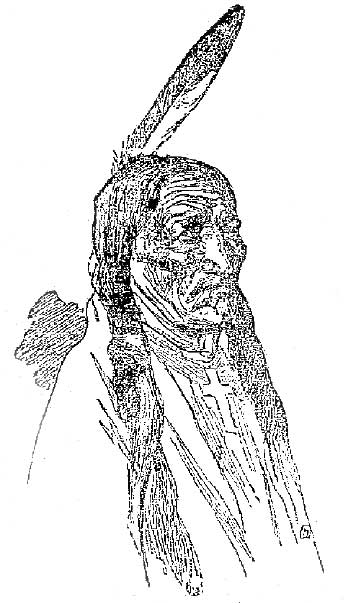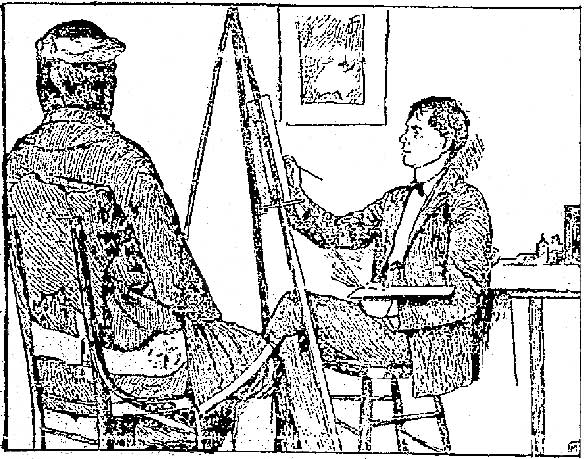
THE INDIANS HIS MODELS
A CHICAGO PORTRAIT PAINTER TO
LIVE A YEAR IN OKLAHOMA.
Chief Wolf Robe, the Arrogant and Haughty,
Knows He is a Good Subject and Demands
$3 a day for Posing
Darlington, Ok., May 25.- E. A. Burbank, painter of Indians, is well on his way to a year's continuous residence in Oklahoma. He came last October for the fourth time and his contemplated work will occupy his time until next fall and perhaps longer. He is again to visit Fort Sill and, will then go to the Red Moon band of Cheyennes, on the Upper Washipa, where he will find entirely new material among Indians, who live so wholly apart from white men, that the latter are despised as cowards and enemies. Burbank grew so intensely absorbed in his work that it became necessary for him to limit his working hours, to preserve his health. He now works only four hours a day. His Indian models think that four hours is a long time, especially if the day be warm and their pose uncomfortable.

CHIEF BURNT-ALL-OVER, CHEYENNE
Burbank's studio is in an upper room of the old hotel here, probably the oldest hotel building in Oklahoma.
An Indian, a chair, a white canvas screen for a background and his paints, brushes and easel are the single inventory of material with which Burbank plies his work. Last week Burbank painted a portrait of Chief Wolf Robe, a Cheyenne, and physically a perfect type of the North American Indian. Wolf Robe knew that he was a valuable subject and demanded a salary of $3 a day, which he received.
The old man is always prompt in his appointments. Painted and feathered and having his great red sandstone pipe, he would stride into the studio with the air of a king, seat himself and, fixing his eyes upon his mark on the wall, sit immovable as a bronze statue until Burbank put aside his paints. He was allowed to rest every five minutes. As the work progressed Wolf Robe was seen to feel the back of his neck carefully and tenderly. His eyes twinkled with a smile when he discovered that he was being laughed at because of his stiff neck caused by his strained posture. A white man's idea of relaxation would be to lie down of the floor or lean back in his chair. Wolf Robe had a different way, however, and, balancing himself on his toes, would sit on his heels like a cowboy and smoke. He was arrogant and endeavored to conceal his interest in surroundings. He accepted cigars with stolid indifference from a man who tried to ingratiate himself, and the only indication that he would like another one was the wistful glance that he gave the butt, which he had pinched carefully and conspicuously on the floor.
INDIAN'S REPUTATION
Burbank knocked off work to shoot from his studio window at a Jackrabbit that had ventured within rifle-shot. Neither Burbank nor his companion could disturb the rabbit, and Wolf Robe was asked to try his luck. The old chief would not risk injury to his pride by possibly missing the rabbit and refused to take the rifle. When alone in the studio, he would examine his portrait with keen interest, but upon the approach of footsteps he would resume his haughty demeanor. Unlike most Indians Wolf Robe had money. Burbank was perplexed to find change for a $5 bill when, to his surprise Wolf Robe produced a pocketbook filled with bills and coin.
Some of the Indians are talkative and jovial. Chief Burnt-All-Over, a Cherokee with a record as a warrior and a face covered with every imaginable line that could zigzag across the human continence, was asked one day to describe how an Indian scalped his enemies. He said that sometimes only the scalp-lock was taken, and again the whole scalp was removed. By Imitation, he showed that after a knife had been drawn around the head the warrior placed one foot on his dead enemy's shoulder and seizing the hair in both hands, jerked the scalp from the skull. The final loosening of the scalp he imitated by the short, quick sound of "plook". Burbank is now painting Lone Wolf, a noted Kiowa Chief.
An artist's studio is always an interesting place. To follow Burbank in his work, unreadable text miracle to a person unfamiliar with the details of painting a picture. Burbank's Indian portraits possess an ethnological value in no way secondary to their artistic merit. Every line, every expression, every feature of the face is reproduced with the exactness of photography. Glancing from his last portrait of Wolf Robe, one of his best efforts, to the subject himself, and then again to the portrait, a person would hesitate to say which was the Indian and which the portrait. Most artists in beginning a portrait tones the entire canvas. Burbank, however, never touches the white canvas where his portrait is to appear. He believes that to tone the entire canvas results in too heavy shadowing. A unreadable text drawing is secured by dividing a canvas into little squares, such as high school students employ.
HOW THE INDIAN PAINTER WORKS
Burbank, and this is a surprising cleverness of his work, seemingly forgets that there is such a thing as a measuring rule. He blocks out roughly in crayon the general outline of his figures, but to the experienced eye the lines carry no suggestion of features or expression. In a full-face portrait he first paints the eyes and goes consecutively to the nose, mouth and cheek. His lines are made with his brush, although they would seem to require the most finely pointed pencil.
His lights and shadows develop with the suddenness of the opening moon-flower. With a subtle touch, a flat mass of color is lifted quickly into flesh that glows with life. To a person devoid of the genius and talent of painting, the acquisition of a knowledge of colors and their combinations would seem a hopeless task. With an eye trained by study, Burbank detects the true color in the face of his model. Then he seeks to reproduce it. A little yellow, a little red, a little blue, a little white are mingled together on his palette, and, coming seemingly from nowhere, the xyz that is transferred to the canvas. "Success in painting", said he, "seldom comes from the schools the individual must have the instinct of color and the talent of drawing. The teacher can call attention to blunders, but he cannot tell the student how to avoid them. A teacher might lecture for years upon the theory of colors, and the student still be unable to reproduce them in their proper relation. The student must learn for himself by normal experience, and, unless the talent be born to him, he will be a failure."
A FIND OF INDIAN STORIES
Burbank has gathered much interesting information concerning Indians. A Navajo, who had traveled with Barnum & Bailey's circus, told him that the Indians thought the audience traveled from place to place with the circus, as the Indians could not understand how so many different people could be found every day. To prove to themselves that their theory was true they decided to watch two certain seats. In the afternoon the seats were occupied by an old man and a little girl and at night by two boys. This upset their theory that the audience traveled with them.
A Kiowa was greatly interested in the East, and spoke of it as "over there". He asked many questions, and wanted to know if "maybe there were twenty tepees" in that part of the country. He said that he was afraid to go "over there: may be get run over and killed by a smoke wagon."
Indian artists paint no wrinkles in costumes, and Indian models always insist that Burbank shall do likewise. Often a group of Indians gather in his studio to watch him paint. The model will ask, "What is he painting now?" An Indian will reply, "Painting buckskin shirt." Whereupon the model will begin carefully to smooth out all the wrinkles. Again, it may be an arm with a sleeve ornamented with beads. The model will slyly twist his arm until all the beads are in sight, causing his arm to look as if it were badly broken.
The Moquis were thieves. They found a bottle of medicine which they liked. Whenever they took a swallow of it, they would make good the deficiency with water. They continued drinking the medicine until the bottle contained nothing but pure water. They stole Burbank's paints. One day he discovered by the paint on an Indian's hand that he had been pilfering. The Indian was told the paint was "bad medicine" and would kill him unless he got rid of it at once. This put an end to paint stealing.

AN INDIAN CHIEF SITTING FOR MR. BURBANK
Burbank induced Geronimo to tell him the story of his life, which he did. Geronimo said that the first thing he could remember was xyz Indians dancing around a fire at night. Geronimo is a great "josher," and often went to Burbank's studio to poke fun at his models. He would say, "Comanche no good." The Comanche would reply, "-Apache no wood. Apache like squaw." whereupon Geronimo would say, "You no good as five cents."
The little son of a Kiowa who was posing for Burbank was making considerable trouble in the studio. He was cautioned by his father several times, but paid little attention to his words until his father said: "My son, you will break my heart if you do not obey me." The child instantly became quiet and sat still until his father was ready to go home. He did not wish to "break his father's heart."
Giaume Honemetah, known as the "belle of the Kiowas," was a pretty, mischievous girl who talked like a magpie to her companions after she became familiar with the studio. The lay figure or dummy which Burbank brought from Chicago was beheld at first with superstitious horror by the Indians. Giaume soon lost her fear and began playing with the figure. She painted the face and dressed the body in gaudy calico until it was transformed into a fairly good Indian.
1901-05-26
Kansas City Star
page 20
Image used with permission from NewspaperARCHIVE.com